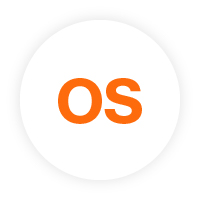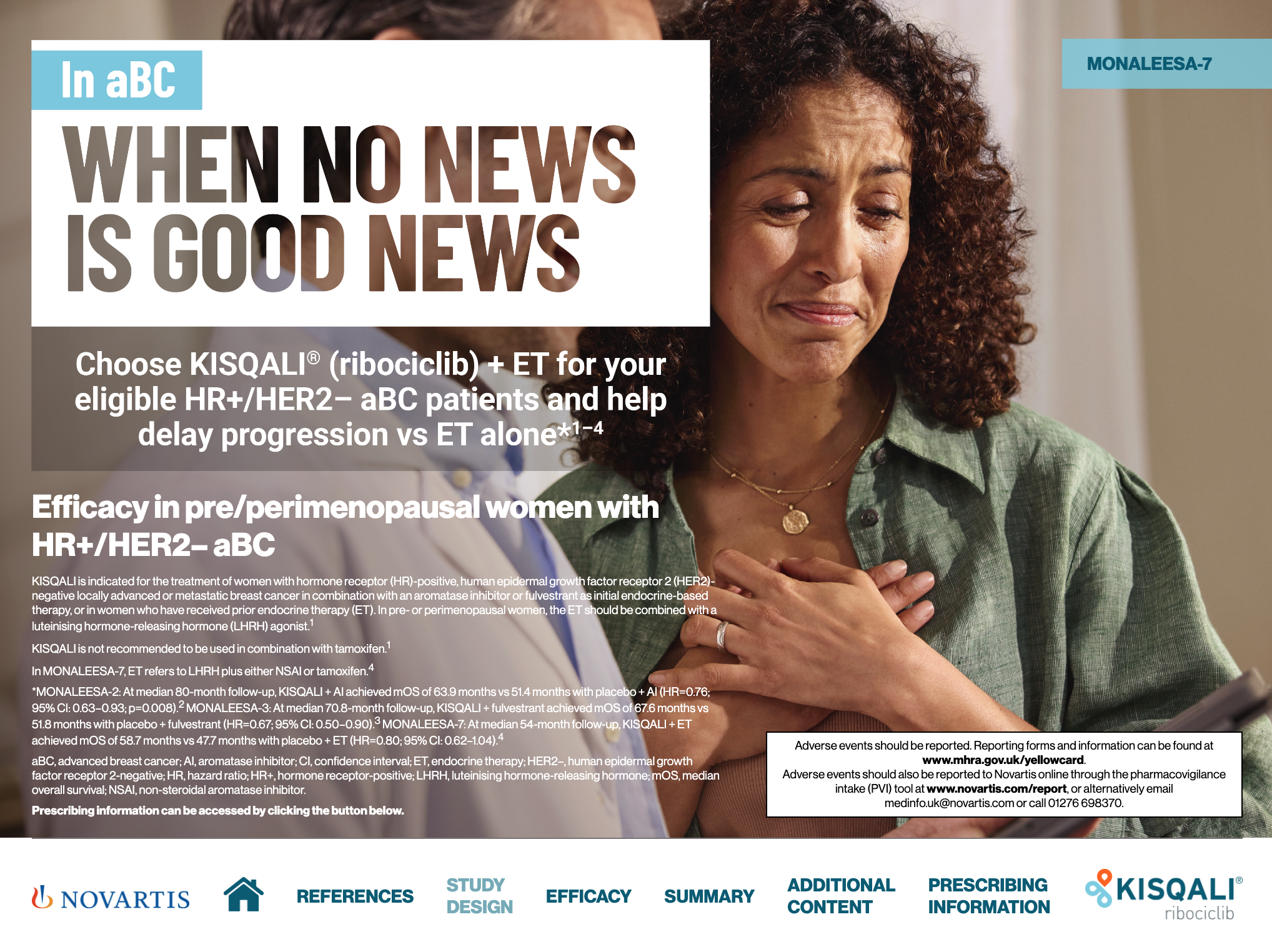Contact us
Our dedicated team of Novartis representatives based throughout the UK are on hand to answer your local query.
This page is intended for UK healthcare professionals and other relevant decision makers only. If you are a member of the public, please click here.
This portal is funded and owned by Novartis Pharmaceuticals UK Ltd and includes content approved by Novartis.
Adverse events reporting information can be found in the footer of this page.
KISQALI is indicated for the treatment of women with hormone receptor (HR)-positive, human epidermal growth factor receptor 2 (HER2)-negative locally advanced or metastatic breast cancer in combination with an aromatase inhibitor or fulvestrant as initial endocrine-based therapy, or in women who have received prior endocrine therapy
In pre- or perimenopausal women, the endocrine therapy should be combined with a luteinising hormone-releasing hormone (LHRH) agonist
KISQALI is not recommended to be used in combination with tamoxifen.
To learn more about the safety profile of KISQALI, visit our portal page, here.
For full safety profile information, please refer to the Summary of Product Characteristics
This was an exploratory OS analysis for the NSAI subgroup with an extended follow-up of median 54 months.4
mOS at median 54-month follow-up was 58.7 months with KISQALI + AI vs 47.7 months with placebo + AI (HR=0.80; 95% CI: 0.62–1.04)4
Primary endpoint, PFS: At a median 19-month follow-up, mPFS in the overall population was 23.8 months (95% CI: 19.2–NR) in the KISQALI + ET* group versus 13.0 months (95% CI: 11.0–16.4) in the placebo + ET* group (HR=0.55, 95% CI: 0.44–0.69; p<0·0001)5
*ET refers to AI + LHRH.4
ET is defined as AI + LHRH or fulvestrant
MONALEESA 2: mOS at median 80-month follow-up was 63.9 months with KISQALI + AI vs 51.4 months with AI alone (HR=0.76; 95% CI: 0.63–0.93; p=0.008). Analysis showed a significant and clinically meaningful increase in OS of 12.5 months with 1L KISQALI + AI vs placebo + AI in postmenopausal patients with HR+/HER2- aBC.7
MONALEESA-3: KISQALI + fulvestrant showed a significant OS benefit over placebo + fulvestrant. The estimated OS at 42-month follow-up was 57.8% (95% CI: 52.0–63.2) in the KISQALI group and 45.9% (95% CI: 36.9–54.5) in the placebo group, (HR=0.72; 95% CI: 0.57–0.92; p=0.00455).6,8
MONALEESA-7: The estimated OS at 42-month follow-up was 70.2% (95% CI: 63.5–76.0) in the KISQALI + ET group (n=335) and 46.0% (95% CI: 32.0–58.9) in the placebo + ET group (HR for death, 0.71; 95% CI: 0.54–0.95; p=0.00973 by log-rank test).9
KISQALI is not recommended to be used in combination with tamoxifen.1
Summary of safety profile
The most common adverse reactions (ARs) (reported at a frequency ≥20%) in the pooled dataset for which the frequency for KISQALI plus any combination exceeds the frequency for placebo plus any combination were neutropenia, infections, nausea, fatigue, diarrhoea, leukopenia, vomiting, headache, constipation, alopecia, cough, rash, back pain, anaemia and abnormal liver function tests.1
For more safety information, click here.
Please consult your local Summary of Product Characteristics for the full KISQALI safety and tolerability profile.
Study design
MONALEESA-2: N=668, double-blind, placebo-controlled, 1:1 randomised, multicentre, phase III trial in postmenopausal women with HR+/HER2− aBC. As 1L in advanced disease. No prior ET for aBC and no previous systemic chemotherapy for advanced disease. KISQALI 600 mg or placebo orally once daily (3 weeks on/1 week off) + AI (letrozole 2.5 mg continuous). The primary endpoint was locally assessed PFS, and the key secondary endpoint was OS. Other secondary endpoints included the ORR (complete or partial response), the CBR (overall response plus stable disease lasting 24 weeks or more), safety, and QoL assessments.10
MONALEESA-3: N=726, double-blind, placebo-controlled, 2:1 randomised, phase III trial. As 1L and 2L in advanced disease plus those with early relapse in postmenopausal women with HR+/HER2– aBC. KISQALI 600 mg or placebo orally once daily (3 weeks on/1 week off) + 500 mg intramuscular fulvestrant. 1L defined as: newly diagnosed (de novo) aBC patients or patients with relapse >12 months from completion of (neo)adjuvant ET with no treatment for aBC or metastatic disease. 2L was defined as: relapse on or within 12 months from completion of (neo)adjuvant ET with no treatment for advanced or metastatic disease (early relapse); relapse >12 months from completion of (neo)adjuvant therapy with subsequent progression after one line of ET for advanced or metastatic disease, and advanced or metastatic breast cancer at diagnosis that progressed after one line of ET for advanced disease with no prior (neo)adjuvant treatment for early disease. The primary endpoint was locally assessed PFS. Secondary endpoints included OS, ORR, CBR, and safety and tolerability.11
MONALEESA-7: N=672, double-blind, placebo-controlled, 1:1 randomised, phase III trial in pre/perimenopausal women with HR+/HER2− aBC. As 1L in advanced disease and in patients who received 1 or fewer lines of chemotherapy for aBC. KISQALI 600 mg or placebo orally once daily (3 weeks on/1 week off) + ET (letrozole 2.5 mg or anastrozole 1 mg) or tamoxifen 20 mg orally once daily continuously + LHRH agonist (goserelin 3.6 mg subcutaneously on Day 1 of every cycle). The primary endpoint was investigator-assessed PFS. The key secondary endpoint was OS, defined as the time from randomisation to death from any cause.9
KISQALI is not recommended to be used in combination with tamoxifen.1
1L, first-line; 2L, second-line; aBC, advanced breast cancer; AI, aromatase inhibitor; AR, adverse reaction; CBR, clinical benefit rate; CDK4/6i, cyclin-dependent kinase 4 and 6 inhibitor; CI, confidence interval; ESMO-MCBS, European Society for Medical Oncology magnitude of clinical benefit scale; ET, endocrine therapy; HER2−, human epidermal growth factor receptor 2-negative; HR, hazard ratio; HR+, hormone receptor-positive; LHRH, luteinising hormone-releasing hormone; mOS, median overall survival; mPFS, median progression-free survival; NR, not reached; NSAI, non-steroidal anti-inflammatory; ORR, overall response rate; OS, overall survival; PFS, progression-free survival; QoL, quality of life.
References
KISQALI® (ribociclib) Summary of Product Characteristics.
Bardia A & Hurvitz S. Clin Cancer Res 2018;24(21):5206–5218.
Azim Jr HA & Partridge AH. Breast Cancer Res 2014;16:427.
Lu YS, et al. Clin Cancer Res 2022;28(5):851–859.
Tripathy MD, et al. Lancet Oncol 2018;19(7):904–915.
Neven P, et al. Breast Cancer Res 2023;25:103.
Hortobagyi GN et al. N Engl J Med 2022;386:942-950.
Slamon DJ, et al. N Engl J Med 2020;382(6):514–524.
Im SA, et al. N Engl J Med 2019;381(4):307–316.
Hortobagyi GN, et al. N Engl J Med 2016;375–1738–1748.
Slamon DJ, et al. J Clin Oncol 2018;36(24):2465–2472.
UK | February 2025 | 442195
Adverse events should be reported. Reporting forms and information can be found at www.mhra.gov.uk/yellowcard. Adverse events should also be reported to Novartis online through the pharmacovigilance intake (PVI) tool at www.novartis.com/report, or alternatively email [email protected] or call 01276 698370.



